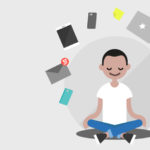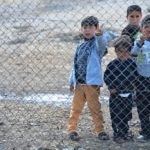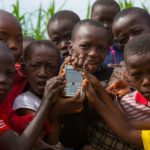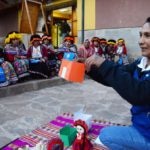Cell phones that change the world
Cell phones have become an indispensable element or our lives. The small screen that holds hundreds of applications and resources for work or play facilitates our day-to-day life. And, in developing countries, the cell phone can be a powerful tool for improving the health, education or the income of the poorest people.

Today, there are more cell phone connections that people in the world, according to data from the Global System for Mobile Association (GSMA), which estimates that seven out of ten inhabitants of the planet have access to a cell phone.
The majority of these people live in developing countries. The mobile penetration rate is so high that, for example, in Africa, it´s easier to find a cell phone than to find drinkable water, according to a recent study by the World Water Council (WWC) . And although in many cases, the devices being used only have voice and SMS services, the arrival of cell phones has served to improve the quality of life of millions of people.
Refugees
In the world today, there are more than 65 million people who have had to abandon their homes, fleeing from poverty or war. Some 75% of these refugees have a cell phone and connectivity is one of their priorities. Specific applications have been created to help them to do the paperwork required for their travels or resume contact with their families.
- Refunite. Allows the user to look for disappeared relatives via the cell phone, website and free help lines. The networks of cell phone operators and the United Nations collaborate on this project.
- Migreat is a tool that facilitates doing the paperwork required to seek asylum. The application offers access to the forms by which to make the request and allows user to compare the rates of approval and the waiting times in different countries.

In the world today, there are more than 65 million people who have had to abandon their homes
Mobile health
-mHealth (medicine by cell phone) is key to preventing illnesses and improving medical assistance in developing countries. The lack of information and the difficulty in movement are the principal obstacles to improving the health of the population.
- Thanks to MAMA, two million women in 70 countries receive vital information on how to have a healthy pregnancy and birth, as well as how to care for the health of their babies.
- Hi4Life uses cell phone messaging services to answer medical questions and send information about sexual health in South Africa. More than three million people use this application, whose objective is to fight sexually transmitted diseases, especially AIDS.
- mHERO is a tool launched by Unicef to maintain contact with its medical personnel. It´s very useful for learning first hand about the advance of epidemics such as Ebola or Zika and gives rapid responses to the heroes who risk their lives on the ground.
Fighting violence and fire
Disease is not the only threat to the survival of the poorest, particularly in Africa, a continent where life expectancy doesn´t reach 50 years in the majority of the countries. War, genocide and natural disasters are some of the plagues that cell phones are helping to combat.
- USAID, the development agency of the United States, has launched a program that allows Kenyans to report incidents of ethnic violence via SMS. With all the information received, a map of danger zones is drawn up, which can be consulted via cell phone. The system also works in the Democratic Republic of the Congo.
- Another ingenious program to improve safety for Africans is that of the mobile firefighters of Kenya. The wooden houses in the poorest neighborhoods of African cities catch fire frequently, provoking real tragedies. The Kenya Red Cross has cooperated with the company Halo Smart Labs to develop a system of smoke detectors that automatically send SMS alerts to the residents of the houses close to a fire, and to the firefighters themselves. In 2025, this program will be implemented in other countries, to the benefit of one billion people.

. The cell phone can be a powerful ally in the education of these young people
Education
In the world today, there are 263 million children that do not attend school, whether for lack of resources in their countries or because they are displaced from their homes. The cell phone can be a powerful ally in the education of these young people.
- Using Vodafone Instant Schools, users can access learning materials online in all the countries where the company operates. The application is designed to function in low-cost devices with a basic connection. These instant schools provide educational resources at the primary and secondary levels.
- A similar application is LiteracyApp, designed so that children who cannot attend school continuously may acquire basic knowledge without a teacher. Thanks to its open-code software, LiteracyApp allows creators from around the world to continue developing this tool and personalizing it, according to the educational system in each country.
Financial inclusion
According to the World Bank, half the adult population of the world – more than 2.5 billion people – do not have access to a current account due to difficulties they have in traveling to a branch office, the cost of maintenance or the complex requirements they often must meet to open an account. This means that these people cannot save, start a business or recover the losses of a bad harvest or a natural disaster. But the cell phone is already helping them to overcome some of these obstacles.

Rut Pelaiza, BBVA Microfinance Foundation in Perú
- M-pesa (“mobile money,” in Swahili) is an application developed by Safaricom that has been functioning since 2007 in Kenya. Currently, it is present in seven African countries, as well as India, Albania and Romania, and has 25 million clients. This service allows persons that do not have access to the financial circuit to be included in it, since they are only required to have a basic cell phone to send and receive money, make payments or recharge the phone. There’s no need to go a bank office, or even to have a bank account, since customers can deposit and withdraw money from a network of agents that includes, for example, the vendors of prepaid cards.
- A similar application developed by USAID to help the Afghan government pay public employees and police offers had the effect, unintentionally, of combating corruption. The bribes that public employees were charged by intermediaries on their wages were reduced so much that the employees thought their salaries had been increased by 30%.
- The BBVA Microfinance Foundation is also committed to using technological innovation to improve the lives of its customers, through a program involving more than 1,000 employees of the Foundation in Peru. Equipped with cellphones, the agents bring the branch office to the home or the workplace of entrepreneurs, saving them hours of travel and transaction costs.